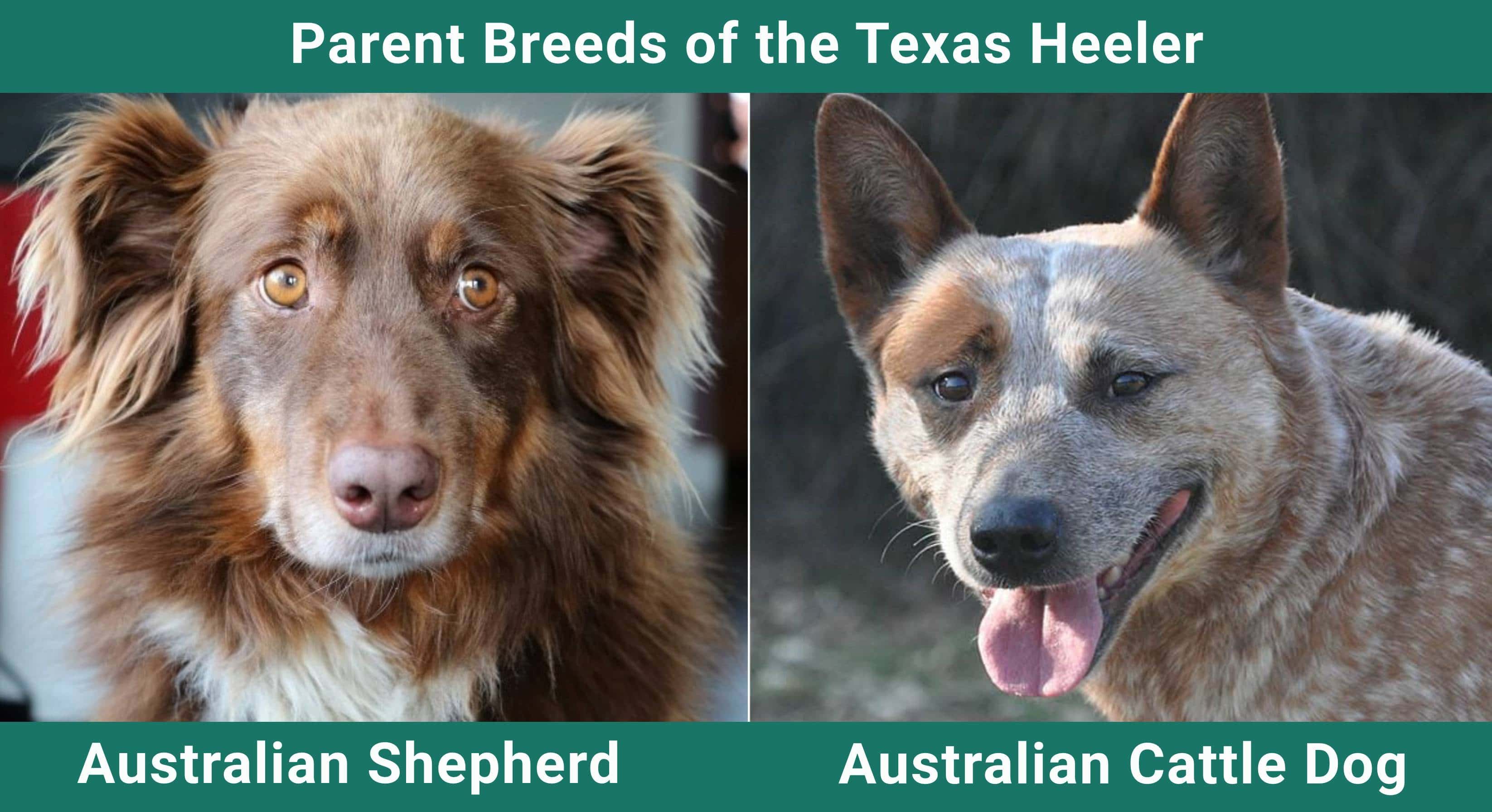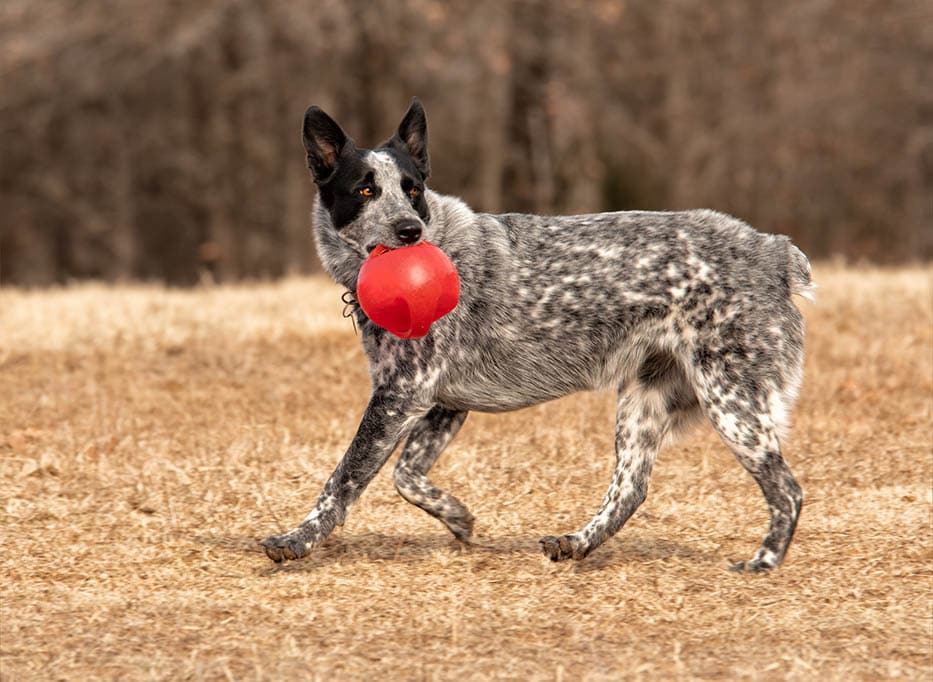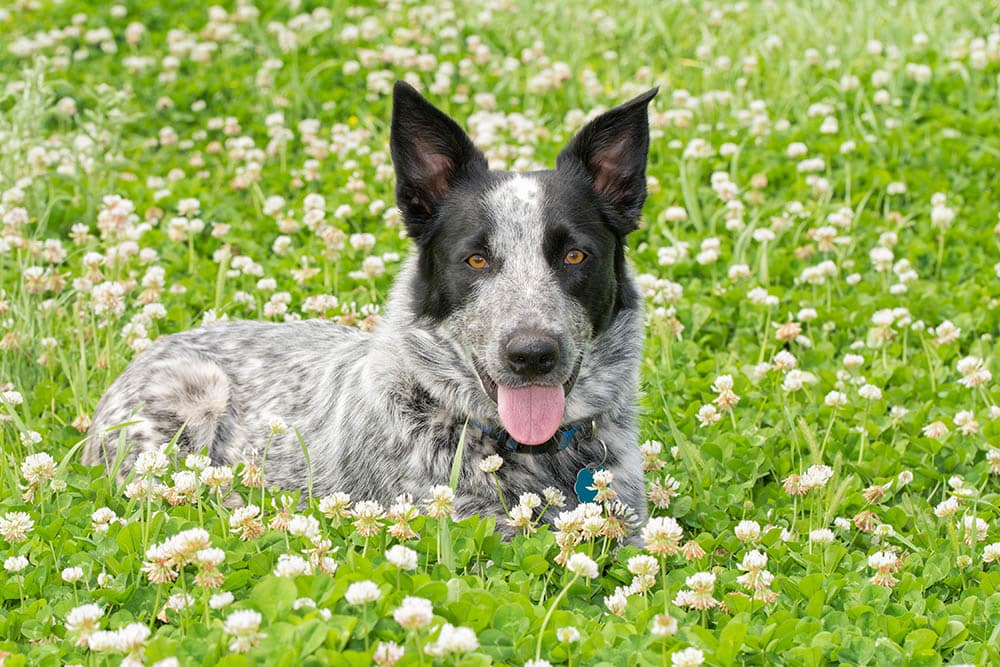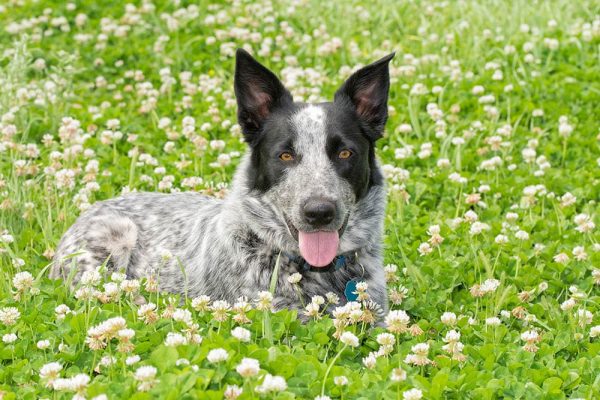Click Below to Skip Ahead
In 1970, the first Texas Heeler litter was born. The happy parents were an Australian Shepherd and an Australian Cattle Dog. Texas Heelers are hybrid dogs that are famous for their herding abilities and infinite energy, and unlike their Aussie parents, they’re considered a purely American breed. With a high IQ and willingness to work hard for their owners, they make excellent herding dogs for ranchers and farmers. Although the puppies are happiest when handling herds of farm animals, they’re also great for suburban families with large backyards. Texas Heelers are dedicated to their human parents, and they make exceptional guard dogs.
Breed Overview
Height:
16-22 inches
Weight:
25-50 pounds
Lifespan:
12-15 years
Colors:
Blue, black tan, white highlights
Suitable for:
Families with older children, ranchers, singles
Temperament:
Energetic, intelligent, loyal, protective
Heelers carry the traits of their herding ancestors, but their appearance can vary. Some are born with bobbed tails, and others have long, straight tails. The canines’ color patterns can be gorgeous blue/gray with specks of white, tan and black, black and white, or other color combinations. Most of the dogs have short coats, but some have long hair that requires frequent grooming. Texas Heelers are rugged animals, but they also seem like they’re smiling when their tongues are out. They bond closely with their owners and can live long, happy lives when their dietary and physical needs are fulfilled.
Texas Heeler Puppies

Texas Heelers have become more prevalent in the last decade, and they’re not as expensive as other designer dogs. Before purchasing a puppy from a breeder, visit the breeding facility so you can see the parents. Also, ask the breeders to meet the father and mother of the puppy before making any decision. This will give you an idea of how the puppy’s behavior will be in the future.
Instead of relying on dog breeders, you can visit a shelter or rescue organization. Most adoptions include up-to-date vaccinations, deworming, and a microchip. Too many animals are euthanized every year due to overcrowding at the shelters, and you can make a difference by giving a rescue Heeler a loving home.
When you bring a Texas Heeler home, have some puppy food, water bowls, a comfy bed, and plenty of treats and toys to make your puppy feel welcome!

Temperament & Intelligence of the Texas Heeler 🧠
Are These Dogs Good for Families? 🏡
Texas Healers are perfect companions for families of all sizes if the dogs have enough room to run around on the property. Untrained dogs will have problems treating kids like farm animals, but luckily, they’re easy to train. Obedience training can dilute their herding behavior and allow them to feel comfortable around tiny humans and even the family cat.
If you and the family go on extended trips frequently, the Texas Heeler may not be for you. They’re incredibly loyal and do not enjoy being alone for long stretches. Since they’re wary of strangers, Texas Healers are difficult to board. Unless you have a neighbor that the dog loves, the animal is unlikely to feel comfortable if it’s cared for by a stranger. If you live in a cramped apartment, you’ll need to find a smaller, less energetic dog.
Does This Breed Get Along with Other Pets? 🐶 😽
With adequate training, Texas Heelers can live happily with another dog or cat. However, they’re likely to get jealous and protest when you’re showing love to the other animals. If they’re introduced to another animal when they’re puppies, they’re more likely to accept them and eventually treat them like family. Because of their protective instincts, it’s best to feed all of your pets at the same time. Feeding a cat before the Texas Heeler is fed may cause the dog to interfere with the feline’s meal. Keep your food bowls in separate locations to avoid any cross-species conflicts.
Things to Know When Owning a Texas Heeler:
Food & Diet Requirements 🦴
When caring for a dog with an active lifestyle and high energy level, you need to provide protein-rich food from a trusted premium company. Look for brands with at least 20% protein and read the label carefully to ensure most of the protein comes from meat. Plant proteins will not harm your canine, but food with meat proteins is closer to the diet enjoyed by the animal’s ancestors.
The pet food market is overflowing with new distributors looking to cash in on a growing industry, and it helps to research each brand before making a decision. Recalls for pet food and treats occur every month, and you can check the FDA website for updating information on the latest recalls. Texas Heelers require three to four cups of food every day split into two feedings. They need plenty of fresh water, and unless you have a water bowl with a large reservoir, you’ll have to fill the bowl at least twice a day.
Exercise 🐕
As previously discussed, exercise is vital to a Texas Heeler’s health. A casual walk every day will not be enough to satisfy the dog’s fitness requirement. They make excellent jogging or hiking partners, and they love to run in open fields and pastures. Texas Heelers need at least 1 ½ to 2 hours of exercise every day, and if they’re unable to get outside, they can become anxious and irritated.
A Texas Heeler will run around a large backyard for exercise, but they’ll expect you to participate. They’re used to herding, and if you cannot provide sheep or goats for herding, you can run with one or play catch to keep them motivated and happy. They live to please their owners, and solo games are ineffective because they go against the dog’s instinct to work.
Training 🦮
Some high-energy mixed breeds are challenging to train, but the Texas Heeler is not one of them. They’re very smart, and they enjoy learning new techniques and commands. Before enrolling in training, you’ll have to decide if you want to modify the dog’s herding traits. Herding is an ideal trait when the owner lives on a ranch or farm, but it may not be suitable for families with multiple infants.
Texas Heelers respond well to training, but they’re not receptive to negative reinforcement. Hitting the animal or pushing it into a doggy pile on the carpet is not only cruel and unnecessary, but it will also erode the trust the dog has in you. They can seem hyper at times and hard to manage, but they’re only excited to be with you and find new ways to release their boundless energy. Use firm commands without yelling and reward the dog with a nutritious treat when it completes a task or repeatedly follows a command. Patience is a crucial virtue during training, but you can rest assured that the process is much easier with a breed (like the Texas Heeler) that enjoys the experience.
Grooming ✂️
Grooming duties for a short-haired Heeler are minimal, but it still needs weekly brushing. You will not need a dematter for a short-haired dog if you keep the coat clean and free of debris. With a long-haired dog, you should brush it at least twice a week or more to keep the coat shiny and healthy.
The dog’s nails grow fast, and they should be clipped at least once a month. Some Heelers become irritated when you touch their paws, but you ask a family member to assist and provide treats after the session ends to show your pup the process is not scary. To avoid tartar build-up and prevent infections, you can brush the canine’s teeth at least twice a week. Only use toothpaste formulated for dogs and contact your vet for tips on brushing correctly.

Health and Conditions ❤️
Texas Heelers can live 15 years or longer, but they are susceptible to many conditions and diseases that affect the Australian Shepherd and Australian Cattle Dog. Feeding your pup a high-protein diet, taking care of the grooming, and giving it frequent exercise will minimize its chances of developing a medical problem.
- Hypothermia
- Hereditary deafness
- Cataracts,
- Obesity
- Hip/elbow dysplasia
- Progressive retinal atrophy
- Collie eye anomaly
- Distichiasis
- Osteochondritis dissecans
Male vs Female
Males tend to be a little heavier and more muscular than female Texas Heelers, but there are no notable differences in their behaviors. However, both male and female dogs are easier to train and control when they’re fixed at an early age.
3 Little-Known Facts About the Texas Heeler
1. The Texas Heeler Is Not Recognized as an Official Breed
Although the Texas Heeler is a mix between an Australian Shepherd and an Australian Cattle Dog, the Cattle Dog parent can come from two different dogs. Original Cattle Dogs and Queensland Heelers are both used for breeding Texas Heelers. With so much variation in the parents’ lines, there’s no established breeding standard for the dogs.
2. Texas Heeler Are Water Dogs
Exercise is crucial to a Texas Heeler’s health, and if you have a pool or pond on your property, the dog will likely be your friend for life.
3. An Untrained Texas Heeler May Attempt to Herd Young Children
Texas Heelers can be trained to interact with children, but they’re easier to control around older kids. The dog would not intentionally attack a toddler, but it can knock a child on the ground when it thinks it needs to herd the young human.
Final Thoughts
With love for outdoor games and a friendly smile plastered on its face, the Texas Heeler is a remarkable animal that’s bursting with personality and affection for its owner. They’re not for small apartment residents or owners who dislike exercising with their pets, but they’re great for families and rural residents with plenty of land. Texas Heelers are loyal companions that rarely bark unnecessarily, but they’re quick to alert the family to danger and prepare to defend the home.
Owning a working dog is not for everyone, but the lucky families that care for them are unlikely to find another breed that’s as reliable and willing to please its family.
See also:
- Why Does My Dog Sleep With Me? 5 Usual Reasons
- Why Do Female Dogs Hump? 5 Vet-Reviewed Reasons & How to Stop It
Featured Image Credit: Sari ONeal, Shutterstock










